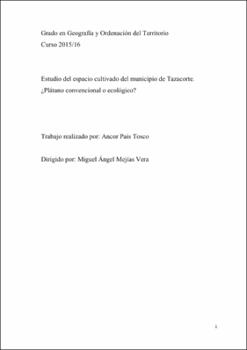Estudio del espacio cultivado del municipio de Tazacorte. ¿Plátano convencional o ecológico?
Author
Pais Tosco, AncorDate
2016Abstract
El plátano convencional en los últimos años ha experimentado cambios importantes a
nivel económico. Estos cambios han perjudicado en mayor medida a los cosecheros de
este producto. Esta situación ha llevado a que los agricultores tengan una situación de
dependencia absoluta de la subvención europea para poder mantenerse. La situación se
ha visto agravada principalmente por los bajos precios que se les pagan a los cosecheros
en almacenes y cooperativas, pagándose precios que no le permiten al agricultor cubrir
gastos. Frente a este, encontramos el cultivo ecológico de plátanos, el cual parece ser un
camino más que lógico a seguir. Mientras los precios del plátano convencional caen, en
algunos meses más que en otros, el precio del plátano ecológico que reciben sus
cosecheros, se caracteriza por la estabilidad y alto precio durante todo el año, situándose
en torno a los ochenta y cinco céntimos por kilo.. Entonces, ¿por qué no se apuesta por
un modelo ecológico? ¿Qué parcelas podrían ser óptimas para el cambio? The conventional banana in recent years has undergone significant changes to the
economic level. These changes have affected to a greater extent to the growers in this
product. This situation has led to that farmers have a situation of absolute dependence of
the European subsidy in order to be maintained. The situation has been aggravated
mainly by the low prices that are paid to the growers in warehouses and cooperatives,
paying prices that do not allow farmers to cover expenses. Compared to this, we find the
ecological cultivation of bananas, which seems to be a much more logical to follow.
While the prices of conventional banana fall, in some months more than in others, the
price of the ecological banana that receive their growers, is characterized by stability
and high price throughout the year at around eighty-five cents per kilo. Then, Why not
bet by an ecological model? What space could be optimal for change?




